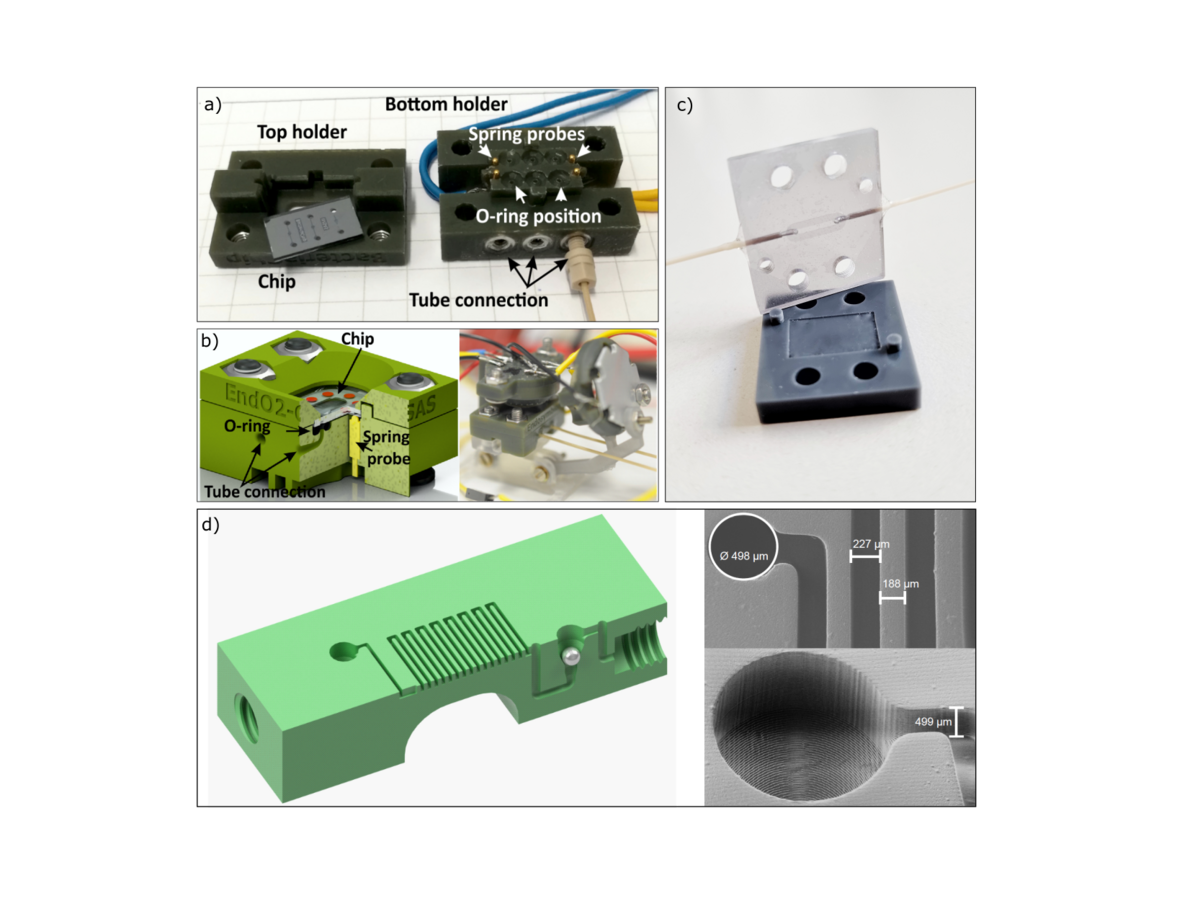3D microfluidic chip holders and systems

Summary:
The adoption of microfluidic devices is often slowed by packaging challenges, especially reliable connections to the macroworld, and limitations of planar chip fabrication technology. We have revolutionized our packaging approach to 3D-printing custom chip holders and we amended our device possibilities with completely printed fluidic systems.
Project description:
For microfluidic systems, additive manufacturing opens not only the third dimension, but also tackles often overlooked challenges of packaging and connections to the macroworld. As our primary application we now print reusable microfluidic chip holders with custom electrical (a, b), fluidic and optical fiber connections easily adapted to individual microchips. The fluidic connections in the chip holder can also be designed in a fully 3D manner, allowing a redirection of chip openings on the top or bottom surface leading to capillaries connected to the side of the holder (a, b). These holders typically require no gluing and rely on sealing by a flexible material clamped or screwed together. For that we use O-rings in order to seal in- and outlets (a, b). Moreover, we directly 3D-print self-sealing channel walls from a flexible Material. Here, we combine a transparent polymer with a flexible one in a single part (c), for instance, to enable optical analysis inside the channel. Not only simplifies this approach the chip packaging and handling drastically, we also achieve considerably better, more reliable and reusable fluidic sealing. Furthermore, certain fluidic functionality such as reservoirs or filters can be designed and integrated directly into the holder. Last but not least, we print movable holders e. g. for a light emitting diode and a photodiode to adapt the angles of incidence and reflection (b).
Expanding upon the chip holder concept, we are also exploring fluidic systems completely printed in one device. Here we can take advantage of the three-dimensional freedom to realize, e. g. completely round channels and outer dimensions similar to flow vessels in nature and industry, arbitrary spatial flow directions, both internal and surface channels, and we can integrate free-moving parts and the necessary fluidic connections in a single printed device. Minimal feature sizes around 100 µm are possible. Current device examples include fluidic mixers with free-moving check valves (d), active valves and pumps with integrated moving parts actuated by external magnetic fields.
Contact:
Dr. Sander van den Driesche
IMSAS, NW1, Room O-2080
Tel: +49 421 218 62652
E-mail: sdriescheprotect me ?!imsas.uni-bremenprotect me ?!.de
Camilla Konermann
IMSAS, NW1, Room O-2150
Tel: +49 421 218 62605E-mail: ckonermannprotect me ?!imsas.uni-bremenprotect me ?!.de
Wiebke Gehlken
IMSAS, NW1, Room N-2160
Tel: +49 421 218 62613
E-mail: wgehlkenprotect me ?!imsas.uni-bremenprotect me ?!.de
Sina Reede
IMSAS, NW1, Room O-2150
Tel: +49 421 218 62579
E-mail: sreedeprotect me ?!imsas.uni-bremenprotect me ?!.de
Selected Publications
S. Reede, I. Eichhorn, M. Oellers, A. Schander & M. J. Vellekoop, “Two-Photon Polymerized Flow Sensor Integrated in a Microfluidic Channel with Optoelectronic Readout”, In 2020 IEEE Sensors (pp. 1-4). (2020) IEEE.
S. v. d. Driesche, F. Lucklum, F. Bunge, and M. J. Vellekoop, “3D Printing Solutions for Microfluidic Chip-To-World Connections”, Micromachines9 (2018) 71. DOI:10.3390/mi9020071
S. v. d. Driesche, F. Bunge, F. Lucklum, and M. J. Vellekoop, “3D-Printing: An Attractive Tool to Realise Microfluidic Chip Holders”, 3rd Conf. MFHS (2017) 94.
F. Lucklum, P. Vaidyanathan, and M. J. Vellekoop, “Demonstration mehrerer MST-Funktionalitäten mittels hochauflösender Stereolithographie anhand eines 3D mikrofluidischen Mixers”, MikroSystemTechnik Kongress (2015) 190.
back to projects group Vellekoop

